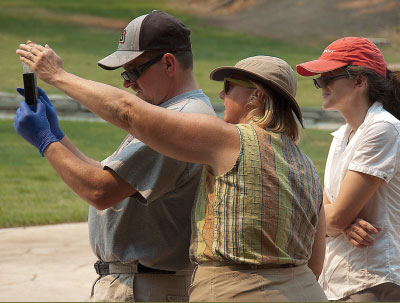CWC faculty fosters research, co-curricular learning
January 1, 2012

With resources from a National Science Foundation (NSF) grant, a team of Central Wyoming College faculty is intent on building a culture of undergraduate research while establishing a model program for co-curricular learning at Central.
CWC has been invited to be part of the Community College Undergraduate Research Initiative (CCURI), a consortium of 35 community colleges nationwide, said Suki Smaglik, Professor of Earth and Physical Science, who applied on behalf of fellow science faculty who were already conducting undergraduate research.
Smaglik along with Biology and Microbiology Professor Steve McAllister and Environmental Sciences instructor Jacki Klancher plan to incorporate research into several of their science courses using an inquiry-based teaching model where students are exposed to real world science through a case study.
Other members of the undergraduate research team at Central are Cheryl Veggian, a CWC graduate in Environmental Science and Leadership who participated in most of the research projects at CWC and is still involved with several projects, Cory Daly, CWC’s librarian who has been named the Associate Vice President for Student Services, and Division Dean Mark Nordeen, an administrator who has a background in the sciences. CCURI has determined that involvement by administrators is essential to the success of the project.
The goal is to give students in biology, microbiology, geology and environmental science courses the chance to do research on open-ended, real-world questions with no predetermined answers, allowing them to experience all the rewards and frustrations that come with that work.
“With our emphasis on co-curricular learning, this is a perfect set up,” Smaglik said, explaining CWC is now requiring all degree-seeking students to participate in some type of co-curricular learning.
The consortium will provide the college with experts who will turn current CWC research projects into case studies to use in the classroom that will involve all students who are enrolled. The case study creates a scenario utilizing data collected by the CWC research teams along with national and regional data. The study then creates research questions for students to investigate and solve by collaboration in the classroom.
By exposing first- and second-year students to open-ended research projects, Smaglik said the faculty hopes that the students’ curiosity is piqued and they become more engaged in scientific inquiry. “We want to increase the number of students who matriculate into CWC science programs and enhance collaborative learning in the introductory level classes using the case study approach,” she said.
Smaglik, McAllister and Klancher will begin incorporating the research component into the classes and expand it into other courses taught by fellow faculty. “We really want to develop a research culture,” Smaglik said. “We want it to be what students are coming here for.”
While it is rare for community colleges to engage in undergraduate research, most of Wyoming’s community colleges are doing so because of grant opportunities from the IDeA Networks of Biomedical Research Excellence (INBRE), NASA Space Grant and another NSF program called EPSCoR (Experimental Program to Stimulate Competitive Research).
Funds from these programs are uncertain, so it is fortunate for CWC to be a part of the initiative because it provides approximately $60,000 in funds over four years for equipment and supplies as well as faculty and student development.
CWC is the only college in Wyoming to be in the consortium. The funding for CCURI is exceptional in that the NSF awarded only one grant of this type this year, and it is the first time that an award of this magnitude has been given to a community college.
“We are a model for the university for undergraduate research,” she said, explaining that only juniors, seniors and graduate students get an opportunity to participate in research projects at Wyoming’s only state university. “This allows our students to become competent and confident when they go on to a university.”
The overall goal of the initiative is to encourage more students to pursue careers in science, technology, engineering and mathematics, the so-called STEM fields.